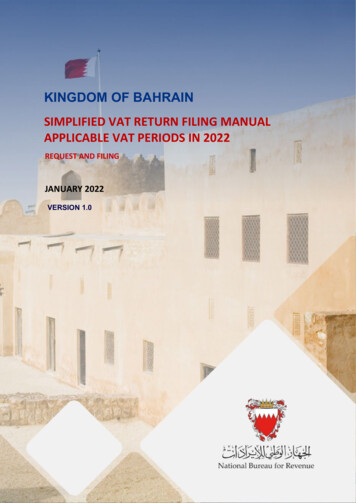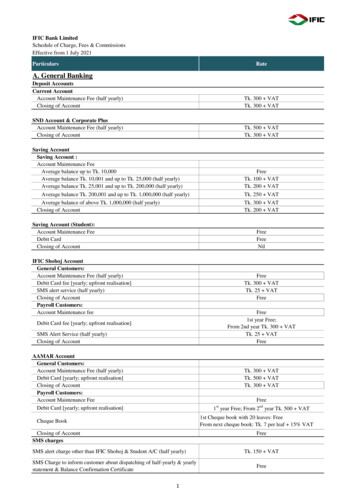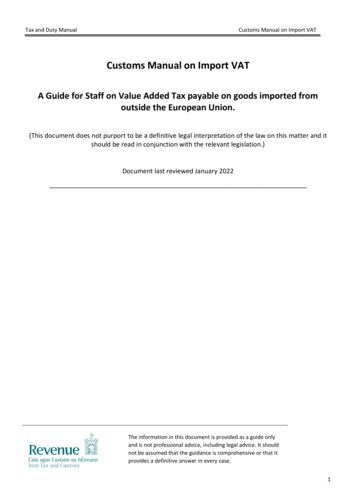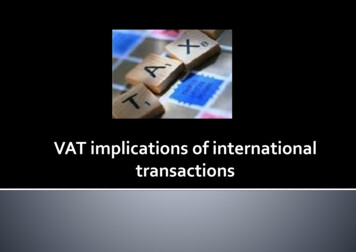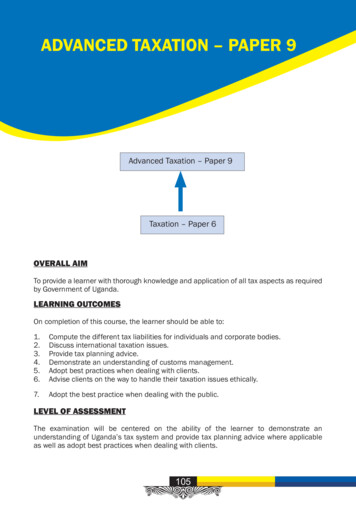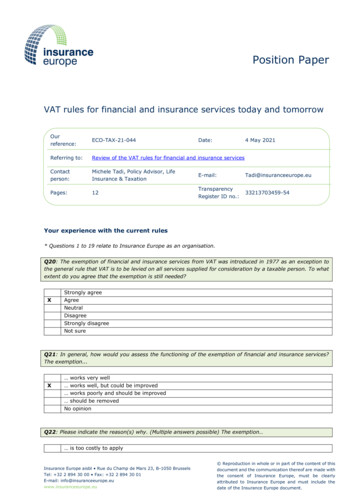
Transcription
Position PaperVAT rules for financial and insurance services today and tomorrowOurreference:ECO-TAX-21-044Referring to:Review of the VAT rules for financial and insurance servicesContactperson:Michele Tadi, Policy Advisor, LifeInsurance & sparencyRegister ID no.:33213703459-544 May 2021Date:Your experience with the current rules* Questions 1 to 19 relate to Insurance Europe as an organisation.Q20: The exemption of financial and insurance services from VAT was introduced in 1977 as an exception tothe general rule that VAT is to be levied on all services supplied for consideration by a taxable person. To whatextent do you agree that the exemption is still needed?Strongly agreeXAgreeNeutralDisagreeStrongly disagreeNot sureQ21: In general, how would you assess the functioning of the exemption of financial and insurance services?The exemption. works very wellX works well, but could be improved works poorly and should be improved should be removedNo opinionQ22: Please indicate the reason(s) why. (Multiple answers possible) The exemption is too costly to applyInsurance Europe aisbl Rue du Champ de Mars 23, B-1050 BrusselsTel: 32 2 894 30 00 Fax: 32 2 894 30 01E-mail: info@insuranceeurope.euwww.insuranceeurope.eu Reproduction in whole or in part of the content of thisdocument and the communication thereof are made withthe consent of Insurance Europe, must be clearlyattributed to Insurance Europe and must include thedate of the Insurance Europe document.
is too complex in terms of notions (structural provisions and the definition of exempted services)X is not clear in terms of notions (structural provisions and the definition of exempted services)X may have a distortive effect on competition with businesses in other Member StatesOtherNo opinionQ23: Please indicate which other reason(s):The industry believes that exemption provisions should be updated and redefined to take account of recentdevelopments in the financial services space: eg new technologies and the uptake of fintech. The current wordingof the VAT Directive leads to a restrictive interpretation of the scope of the VAT exemption on insurance andrelated services by the ECJ. In practice, outsourcing any function specific and essential to insurance operationswill lead to irrecoverable VAT, unless there are specific arrangements.Complexity and lack of clarity on how to interpret the exemption, such as the different definitions of insurancerelated services among member states, lead to higher costs in terms of VAT administration, and — in specificinstances — can create distortions of competition between member states.Insurance companies are consumers and providers of financial services, either to group affiliates or third parties,and as a result face the same difficulties as other financial institutions. The narrow scope of the VAT exemptionhampers the mutualization and delegation of important functions and hence a more efficient functioning of theinsurance market.As it currently stands, insurance and reinsurance benefit from a VAT exemption provided for by point (a) ofArticle 135 (1) of Council Directive 2006/112/EC and the overall competitiveness of the insurance sector wouldof course benefit from ways allow for more VAT reclaim. The legal framework for Solvency II foresees thepossibility to outsource certain functions. It should be noted that claims management, asset management andother administrative functions are difficult or costly to outsource, in particular as a result of uncertainty arisingout of application of the VAT regime.Another difficulty relates to an unlevel playing field, for example, the administration of the portfolio of a lifeinsurance product when it is subscribed as an investment and saving product. This insurance product will incertain cases fall in direct competition with special investments funds, but will not enjoy the same VAT benefit.Where the administration and portfolio management of an investment fund is VAT exempt, which is not thecase for most life insurance schemes, the cost structure of the life insurer will be impacted and some costs willbe passed on to the investor.Q24: How do you estimate the impact of the lack of input tax deduction and hidden VAT? (Multiple answerspossible)XThey create a price barrier to outsourcingXThey undermine the level playing field between providers of outsourced services and in-house providersXThey affect the business structures of those operating in the financial and insurance sectorXThey increase the costs for business customersThey increase compliance costsThey undermine the competitiveness of the sectorXOtherDo not know2
Q25: Please indicate which other reason(s):As insurance is a VAT-exempt business, insurers find themselves in the position of the final customer whenoperating, therefore bearing all irrecoverable VAT incurred from buying the goods and services needed.Outsourcing functions essential to insurance activities become increasingly expensive. So, even if they are nothindered, their cost affects that of insurance services purchased by both private and business customers.As regards general insurance, the final cost becomes even higher when considering all irrecoverable inputcosts, such as hidden VAT, Insurance Premium Tax and other parafiscal levies that may be applicable to theinsurance premium.For instance, in France, VAT-exempt businesses are liable to a payroll tax. The expected implementation ofVAT groupings in France as of 2023 may also have an impact on the cost of resorting to a third-party serviceprovider. In Denmark, payroll duty is equally applicable at a rate of 15.3% of the total salaries relating to VATexempt financial services.In addition to that, the lack of legal certainty also creates a lack of commercial certainty. Clarifying itsrequirements may improve its effectiveness.Q26: The compliance with VAT rules can be more difficult when supplying financial and/or insurance servicescross-border. How do the factors listed below contribute to that effect?Not at allDifficulty of finding information on VAT obligations in otherMember StatesSomewhatNoopinionXXDifferent interpretations on definitions of exempted servicesDifferent rules for opting to taxTo alargeextentXAvailability of VAT groupingXAvailability of cost-sharing arrangementsXDifferent deduction methodsXDifferent VAT obligations in other Member StatesXOtherXQ27: Please indicate which other factor(s):Many insurers, like other financial institutions, and multi-nationals in general, operate cross-border. They canserve clients in other member states through the free provision of services or via local establishments, and theycan have affiliates in other countries with whom they share resources, exchange services, etc. These varioustypes of transactions, including a multitude of payment flows, must all be analyzed from a VAT perspective.Because of the complexity of the VAT rules due to territoriality and the absence of detailed guidance, the VATtreatment of the same service will sometimes be different in the two countries involved. Beyond possible doubletaxation, this leaves insurers exposed to fines and penalties when they choose to apply one country’s position.VAT groups are another example: in the CJEU Skandia jurisprudence, for instance, the case initially addresseda situation where VAT was eliminated and potentially closed the door for aggressive optimizations. However, bydoing so, it also largely impacted the operational costs of head-office branches structures which were genuinelyoperating within the EU. Previously, any services shared between head offices and branches were disregardedfor VAT purposes as rendered within the same legal entity. At present, as soon as the receiving establishmentis a member of a local VAT group, it suffers an irrecoverable VAT cost on internal cost allocations. The same3
happens in various member states in what are called “reverse-Skandia situations”: ie when the supplyingestablishment is VAT-grouped locally. We note that the reverse Skandia is currently subject to a preliminaryruling by the CJEU in the Danske Bank case. Insurance groups operating with branches in the EU are numerous,and this trend is increasing for various reasons. Several important functions are mutualized between the headoffice and the branches, as in the single market financial institutions are allowed to utilize single passports andat the same time are forced, due to regulatory reasons, to have separate entities licensed for various businesses(eg life and non-life insurance). They also face a major VAT burden where services are provided both crossborder and in one member state. Therefore, this jurisprudence has had a very detrimental effect in the wholesector.The legislation should therefore take the current situation into account.Q28: Do you think that the current rules hinder the development of cross-border supplies of financial andinsurance services?XYesNoDo not knowQ29: Please indicate the reason(s) why.Regulatory ecosystem too complexVAT rules for financial and insurance services too complexXDiscrepancies across VAT treatment by member statesXOtherQ30: Please indicate which other reason(s):With respect to the impact on financial services in general, there are clear benefits in harmonising the treatmentof VAT. For example, with regard to insurance services, administration fees of certain unit-linked products arenot exempt but similar/ competing services for UCITS are exempt. There are also different regulations in severalmember states on IPTs, which also may create competitiveness issues.The different interpretations of the EU Directive, CJEU decisions and different national rules on VAT groupingcreate an uneven level playing field for the industry, which creates competitiveness issues because, to provideinsurance services, insurers are large consumers of financial services, some of which are liable to VAT. In suchcases, VAT reverse charge rules apply and may cause major hardships in the course of cross-border operations.Q31: To what extent are the foreign VAT rules for financial and insurance services important when decidingwhether to establish your business in a specific Member State?Very importantXImportantNot very importantNot important at allNo opinion4
Q32: Which of the structural provisions listed below do you apply? (Multiple answers possible)Option to taxXVAT groupingXCost-sharing arrangementsXProportional deductionXOtherNoneQ33: Please indicate which other provision(s):An example of other provisions can be provided by the situation in Luxembourg, where cost sharing servicesare no longer available. Upon their removal, there were significant additional costs for groups who had to taxagain the mutualized service.Q34: The exemption was put in place i.a. due to the technical difficulty to calculate the taxable amount. Towhat extent do you agree that progress in technology, enhanced transparency rules and experiences gainedfrom other countries and from other indirect taxes could help overcome this issue?Strongly agreeAgreeNeutralXDisagreeStrongly disagreeDo not knowQ35: Do the current VAT rules for financial and insurance services result in prices lower than those that wouldapply if these services were taxed?Yes, but just for final non-taxable customersYes, for all customersIn part, due to other similar taxesXNoDo not knowQ36: To what extent are the current structural provisions effective in increasing the deduction of input tax andreducing the impact of hidden VAT?Noteffectiveat allOption to taxSomewhatineffectiveNeithereffective norineffectiveSomewhateffectiveNoopinionXVAT groupingXCost-sharing arrangementsXProportional deductionVeryeffectiveX5
Q37: VAT provisions related to financial and insurance services can be perceived as complex. For which of thecurrent structural provisions is that correct? (Multiple answers possible)Option to taxXVAT groupingXCost-sharing arrangementsXProportional deductionNoneQ38: To what extent do you agree or disagree with the following statement: The lack of input tax deduction isdetrimental to the financial and insurance sector. It compels the sector to outsource services which are typicallyprovided in-house, thus raising the costs.Insurance Europe did not provide an answer to Q38. There is no direct link between the lack of input taxdeduction and the outsourcing of input services and therefore it would not be possible to answer to the questionas it is currently formulated.Q39: Unless you make use of the option to tax, does your business incur any costs related to irrecoverable(hidden) VAT?XYesNoDo not knowMy business is applying the option to taxQ40: To what extent do you agree that the current VAT rules are fit to cover emerging trends in the industry(such as digitalisation)?Strongly agreeAgreeNeutralXDisagreeStrongly disagreeDo not knowQ41: The VAT treatment of emerging trends under the current VAT rules for financial and insurance servicescan be problematic due to unclear definitions for VAT purposes. In connection with which of the emerging trendslisted, do you consider this correct? (Multiple answers possible)XServices provided by means of fintechE-moneyServices linked to crypto-assets (such as mining)XPayment servicesXOtherDo not consider it problematicDo not know6
Q42: Please indicate which other trend(s):The possible answers include a partial list of still developing services. Because these services are new, and theirdefinitions have not yet formed, at this stage the assessment of their impact on the financial and insurancesector is not fully clear and therefore it’s not possible to indicate a clear emerging trend whose treatment couldbe problematic.Insurance Europe would like also to include in this list the provision of insurance intermediary services via digitalprocesses, and mediation and distribution services, which should to be VAT exempt to the same extent as theunderlying financial transaction, including any cross border component.Q43: The regulatory framework in the financial and insurance sector (e.g. the Markets in Financial InstrumentsDirective (MIFID) and the Insurance Distribution Directive (IDD)) has strengthen the role of intermediaries. Doyou consider the VAT exemption to be coherent with this development?YesXNoDo not knowPossible changes to the current rulesThe Commission is intending to prepare a proposal that will seek to modernise the current VAT rules for financialand insurance services. Your answers will feed into the review of these rules.Q44: In your view, which would be the best way to reform the rules on exemption? (Multiple answers possible)XUpdate definitions of exempt services drawing on the extensive CJEU case law in the field of VATXAs regards the definitions, refer to other EU regulations governing the financial and insurance sectorRemoving the exemption, so that definitions will be no longer neededXOtherDo not knowQ45: Please indicate which other way(s):A future well-functioning set of exemptions on financial services will require new legislation with a clearpreamble, fully replacing the current rules.We urge the Commission to redefine the exemption taking into consideration recent developments: ieoutsourcing of certain functions is now largely possible and dealt with in the Solvency II legal framework. Manyoutsourced services may not benefit from a VAT exemption with a narrow interpretation of the directive.The current case law could be considered when designing the exemptions, however should be disregarded forfuture interpretation, since the criteria laid down by the CJEU for a financial service to be exempt (ie beingspecific and essential to the provision of an exempt financial service) are not concrete enough to provide legalcertainty for the parties involved to rely on. The explicit inclusion of the main outsourced functions like claimsmanagement, underwriting, asset management for insurance products should be clearly stated and not left tointerpretation.7
Finally, an option to tax may be taken into consideration only for some classes of insurance. In that case, shouldan option to tax be mandatory in all member states, it would also have to be combined with provisions forbiddingany cumulative application of VAT along with IPT or any other similar tax.Q46: The removal of the exemption for financial and insurance services could benefit the neutrality of the VATsystem. What could be other effects of such a removal? (Multiple answers possible)XSimplification in the application of the VAT rules for financial and insurance servicesLower VAT compliance costsLess distortive effect of the exemption on competition linked to suppliers from non-EU countriesoperating in the EUHigher VAT compliance costsHigher complexity of VAT rulesNoneXOtherQ47: Please indicate which other effect(s):The interaction of VAT with the different national tax regimes for financial services must be carefully examinedto ensure a level playing field in the interest of policyholders and avoid any increase in the costs of insurancecontracts.Depending on how such measure is implemented (eg definition of the tax base, scope and terms of VATdeduction rights, combination with other taxes applicable to insurance premiums, etc), removing the VATexemption for insurance services may open a wide range of unsolved issues.The price of insurance products may also increase: if IPT and payroll duty were not repealed, there would resultin an increase in price for consumers as it would effectively lead to double taxation. As it currently stands, IPTsare levied in the vast majority of EU member states at a rather high range of rates and their repeal seemsunlikely, given the generated revenue in some countries (eg 5 bn per year in Italy).In most member states, life insurance, health insurance and pension contributions are exempt from IPT (ortaxed at a reduced rate) in order to keep these insurance products as affordable as possible. If these taxexemptions are not integrated into the new system, price increases for customers of these products would beinevitable.A VAT exemption should remain an available option, in order to avoid re-building an overly complex set of VATrules.Q48: If only fee-based financial services were to be taxed, in relation to which of them would it be difficult todetermine the taxable amount? Please explain.Insurance Europe would like to highlight that insurance is not a fee-based service. A premium is not a fee andit represents the price of the service provided by insurers, which is the risk coverage. Whereas insurers calculatepremiums differently, based on their underwriting process and how they assess the risk, the added value ofsuch service can be seen as the difference between the amount of premiums collected and the amount paid incompensation.The main features of the industry are the insurance cycle, which is an inverted production cycle, and the poolingof risks. The effective amount of paid compensation is usually determined at the end of a cycle when the claims8
related to a generation of contracts arise and such cycles may in some cases have a very long duration, thusmaking the calculation of the difference between these amounts very difficult, if not impossible.Q49: Financial service providers may currently opt for taxation and obtain the right of deduction, but it is up toeach Member State to introduce such option. Should Member States keep that discretion?YesXNo, it should be available in all Member StatesNo opinionQ50: Not having a right of deduction when supplying exempt financial and insurance services impairs theneutrality of VAT. To what extent would you support or oppose the introduction of a fixed rate of input taxdeduction to remedy that effect?Strongly supportSupportXOpposeStrongly opposeNo opinionQ51: If a fixed rate of input tax deduction was introduced, should such a rule remain optional for operators or,alternatively, should it be mandatory?XIt should be optionalIt should be mandatoryNo opinionQ52: Should cost-sharing agreements be made available to the financial and insurance services sector?XYesNoNo opinionQ53: In your view, should businesses established in other Member States be allowed to form part of the costsharing arrangements?XYesNoNo opinionQ54: Please indicate the reason(s) why. (Multiple answers possible)XTo achieve a more level playing field for businesses9
To boost competitiveness of financial and insurance service providersXTo reduce the tax burden and the administrative costs of businesses operating at cross-border levelOtherQ55: Please indicate which other reason(s):To date, cross-border cost-sharing agreements can be organized, but the ECJ case law banned their use byfinancial services and insurance companies. If cost-sharing agreements were to be made available again to theindustry, it would consolidate cross-border groupings, thus allowing the rationalization of their administrativecosts.Q56: If no, please indicate the reason(s) why. (Multiple answers possible)N/AQ57: If no, please indicate which other reason(s):N/AQ58: Which is the most beneficial aspect of establishing VAT groups for providers of financial and insuranceservices?Notbeneficialat allIt is optionalSomewhatdetrimentalNeitherbeneficial ragroup supplies are outof scope and therefore nottaxedXVAT compliance costs arelower for the members of thegroup as they are poolingthemXIt is easier to outsource theactivity through a singletaxable personXVAT grouping increases thecompetitiveness of the sectorby reducing hidden VATOtherNoopinionXXQ59: Please indicate which other aspect(s):Another aspect to consider is the high degree of freedom for the organisational structure. In general, VATgrouping allows the creation of a legal structure best fitting for the financial services companies’ business model,as well as restructuring without limitations resulting from VAT. Additionally business segments that are relevantfrom a regulatory perspective must be separated (ie the separation of property & casualty insurance from lifeinsurance). Individual analysis of the potential application of VAT exemptions on intragroup services (ie financial10
services) is not required, which decreases administrative costs. Other examples of decreasing compliance costsare fewer regulations for inter-group invoicing, the need to prepare less tax returns, etc.In any case, it should be noted that the individuation of a list of benefits of VAT groupings as stated in thewording of this question can be difficult, as VAT groupings are mainly intended at achieving VAT neutralitybetween exempt and liable to tax operators within the same group. Moreover, proportional deduction rules canbe very complex in cases of the outsourcing of some functions.Q60: Which is the most effective way to reform the rules for financial and insurance services in your country?Noteffectiveat allRemove the exemption andtax financial and insuranceservices at a standard rateSomewhatineffectiveNeithereffective ionXRemove the exemption andtax financial and insuranceservices at a reduced rateXTax only fee-based services ata standard rateXTax only fee-based services ata reduced rateXGrant businesses the optionto apply VATXGrant businesses the right toconstitute a VAT group inevery Member StateXMake cost-sharingarrangements available to thesector in all Member StatesXOtherXQ61: Please indicate which other reform(s):See answer to Q62, on the amendment of the VAT Directive to include the cross-border effect for VAT groupsFurther commentsQ62: If you wish to add further information within the scope of this questionnaire, please feel free to do sohere. (2000 characters maximum)Insurance Europe:Urges to explicitly allow cost sharing groups independent of the type of activities conducted by membersof the group.Asks for more clarity and legal certainty for financial and insurance services operators about the scopeof the VAT exemptions to provide a more refined criteria and extensive list of exempt services.Suggests that policymakers investigate how the impact of non-deductible VAT on the cost of doingbusiness of insurers can be limited. Besides the non-deductible VAT, IPT is charged on several insuranceservices in member states and rates tended to increase over the past few years.11
Believes that the introduction of the option to tax should not be in addition to any IPTs to avoid doubletaxation and an increase of costs for insurance coverage for customers.Suggests reconsidering an option to tax property & casualty insurance and continuing the (partially)existing IPT exemption for life insurances, health insurance coverage and pension schemes.Supports the amendment of the VAT Directive to make the option for VAT group treatment mandatoryin every member state to avoid any distortion between financial operators in different countries.Supports the amendment of the VAT Directive to include the cross-border effect for VAT groups to avoidany distortion between financial operators located in different member states and in line with the ECJruling in Case C-386/14. VAT grouping rules must be eased and uniformed, in order to simplify thecreation of VAT groups, allow requirements for VAT groupings to be met by insurance companies andtherefore establishing a level playing field across all member states.Requests the elimination of VAT obstacles to the arrangements needed for insurance business. Thesefeatures should be determined by the nature of the service, rather than by the person providing it. Toachieve a level playing field, outsourced services that are necessary to the insurance business mustbenefit from a VAT exemption.Q63: If you wish to upload a concise document, please do so below. The maximal file size is 1MB. (Only files ofthe type pdf,txt,doc,docx,odt,rtf are allowed) Please note that the uploaded document will be publishedalongside your response to the questionnaire, which is the essential input to this open consultation. Thedocument is an optional complement and serves as additional background to better understand your position.Please see our accompanying document for more details.Insurance Europe is the European insurance and reinsurance federation. Through its 37 member bodies — the nationalinsurance associations — it represents all types and sizes of insurance and reinsurance undertakings. Insurance Europe, whichis based in Brussels, represents undertakings that account for around 95% of total European premium income. Insurancemakes a major contribution to Europe’s economic growth and development. European insurers pay out almost 1 000bnannually — or 2.7bn a day — in claims, directly employ nearly 950 000 people and invest over 10.4trn in the economy.12
insurance services, insurers are large consumers of financial services, some of which are liable to VAT. In such cases, VAT reverse charge rules apply and may cause major hardships in the course of cross-border operations. Q31: To what extent are the foreign VAT rules for financial and insurance services important when deciding
